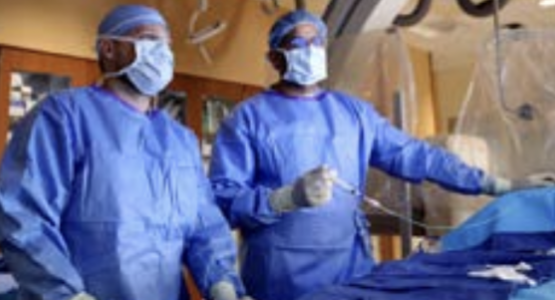
Calling Dr Patel
Story by Ben Riggs
Get Dr. Akil Patel talking about his kids, and you’ll hear his fatherly pride. He leans forward, grins ear to ear, and has countless pictures on his phone. Get him talking about the human brain, and you’ll hear his child-like wonder. He explains it using his hands, eyes widened behind his thin, black- rimmed glasses, and has stories galore on his mind.
The 37-year-old vascular neurosurgeon knows a thing or two about the three-pound organ between our ears. From residency at the University of Maryland to training at Johns Hopkins and Seattle’s Swedish Neuroscience Institute, he has committed all his brain to understanding ours.
“Every brain has its own roadmap,” he says. To navigate those roadmaps, he’s trained as an endovascular neuroradiologist. Like a cerebral cartographer, he maps the brain’s blood vessels using images called angiographies.
He’s also trained as a complex cerebrovascular neurosurgeon, operating on the brain and its 400 miles of blood vessels.
Dr. Patel’s familiarity with the brain and its blood vessels put him on Dr. Robert Lober’s radar. Dr. Lober, a pediatric neurosurgeon at Dayton Children’s, and his colleague Dr. Christopher Gordon, a craniofacial surgeon, were preparing to do what seemed impossible: separate three-year-old Pedro and Augusto, craniopagus (conjoined at the head) twins from Guatemala.
Unlike other craniopagus twins, Pedro and Augusto lived conjoined at the tops of their heads. One was rotated 90 degrees, and they shared major blood vessels. Their situation was, by all accounts, rare.
To treat Pedro and Augusto, Drs. Lober and Gordon first needed to know: Was it possible to separate the boys’ shared blood vessels?
In November 2020, Dr. Lober called Dr. Patel.
Dr. Patel had exposure to rare pediatric cases at Johns Hopkins. But looking at MRIs and CT scans from Guatemala with Dr. Lober, Dr. Patel wrestled to make sense of what
he saw. “I don’t think this is doable,” he first thought. But after hours of deliberating, Dr. Patel envisioned their next move. “Maybe there’s a shot,” he told Dr. Lober. “Let’s do an angiography to see.”
Dr. Patel mentally cycled through the remarkable images. “Can I even really help with this?” he wondered.
He called his wife, Megha, confiding the strain between his willingness and uncertainty.
“Sit down. Take some time,” Megha told him.
So, he did. He studied. He called mentors. And he exhausted the available medical research. And Dr. Patel’s research swayed him enough to call Dr. Lober. “I think we can do this.”
Dr. Patel knew early on this would take him beyond his comfort zone as a surgeon, beyond his familiarity as a specialist, and beyond his confidence as a person. But when he first saw Pedro and Augusto’s date of birth, Dr. Patel knew he would give everything to the boys. Because he is also a father.
“The twins are only 12 days younger than my oldest boy. ‘What if my son were in that situation?’ I thought. So, I put it on my shoulders to say, ‘I’m going to give the best endovascular care I can to these kiddos.’”
After four operations and 14 months of recovery, Pedro and Augusto returned home to Guatemala. A longer recovery process continues, involving plastic surgery and around the clock care. But now, they have a brain and blood supply of their own.
Dr. Patel thinks about Pedro and Augusto often, especially when tucking his own children into bed.
The chance to be involved in this groundbreaking procedure isn’t lost on him. “It’s one of those once-in-a-lifetime kinds of cases. I’ll always look back and say, ‘Wow, I can’t believe we did that.’”
But he shouldn’t be too surprised to have been involved. As Dr. Lober said in Connected, the documentary about the procedures, “If there’s one guy you want in this surgery, it’s Dr. Patel.”
And it wasn’t only because Dr. Patel knows his way around the brain and its blood vessels; it’s because he enters operating rooms with more than his smarts and a scalpel.

Add new comment